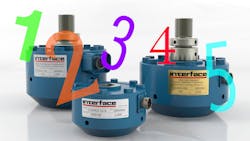Accuracy is a critical factor in modern engineering. It can mean the difference between a solid, reliable, high-quality product and one that fails or quickly becomes a liability to its users. But for as important as accuracy is, it’s quite an ambiguous term in engineering. When someone expresses the importance of accuracy, a lot of questions inevitably follow, especially when it comes to load cells.
Load cells are important for testing and measuring force, weight, and torque on practically any product you can imagine. They are installed on finished products to track force factors in real-time, and in the long-term they assist with preventative maintenance and collecting data for future products.
Load cells are used in everything from equipment that tests stents and heart valves to measuring rocket engines’ thrust. They are used in everyday applications as well as some of the most advanced equipment available, such as robotic surgical arms and the Giant Magellan Telescope.
The Five Factors
What defines accuracy when it comes to load cells? What conditions or factors of load cell accuracy are most important? Each load cell is different and designed with different specifications in mind. Understanding the different factors that affect load cell accuracy and how you can ensure you select the best load cell for you needs is important for engineers.
There are five factors to consider:
Temperature in the air can affect a load cell’s ability to provide accurate measurement due to their sensitivity. Every load cell has a temperature point where accuracy will be affected, but many are designed to deal with extreme temperatures. When selecting a load cell, engineers need to tell the load cell manufacturer about the temperature conditions they are expecting the load to perform under.
Humidity’s effect on a load cell is not as immediate as temperature’s, but over time it can affect the accuracy of its data. Load cells that perform in high-humidity environments must be properly designed for the task.
Creep describes the change in a load cell’s accuracy that result from pressure placed on it under constant load while all other environmental conditions and variables remain constant. Creep is due to the materials slowly deforming when under constant load.
Side and eccentric loads are inappropriate loads for load cells to measure and will reduce the life of the cell while distorting results. Load cells usually measure force in only one direction.
Mounting affects how the load cell and piece being measured interact. If the mounting is off-center, reading will be less accurate. Always follow the mounting instructions that come with the load cell.
Ensuring Accuracy
After you’ve taken account of the first five factors, here are some tips for ensuring load-cell readings are accurate:
Be honest about your projects operating conditions. Always tell the load-cell manufacturer the conditions in which the load cell will be operating. A good manufacturer will help you select the best load cell for your project.
Check worst-case accuracy values on any product specs. Load cells should always include worse-case accuracy values on their specifications. This is important data to evaluate when selecting a load cell.
Ask about the production process for load cells. Every aspect of how a load cell is designed, manufactured, and assembled can affect its accuracy. When working with any load cell manufacturer, ask about their production process to ensure they take accuracy seriously and are in control of the entire production process.
Avoid changing the load cell’s conditions or location. There is a load cell for pretty much every application, but each is created with a specific purpose in mind. If you purchase a load cell for an application and then try to switch the use-case, it is likely that accuracy will be degraded.
Regularly recalibrate and plan preventative maintenance. A quality load cell should last a long time. I’ve seen load cells last over 50 years. For long-term accuracy and quality, establish a preventative maintenance schedule and recalibrate the load cells based on the manufacturer’s suggested timeframe. As a rule of thumb, it is usually recommended to annually recalibrate load cells and more often on the front end of its life to get the best results.
Ken Vining is the chief engineer at Interface.
